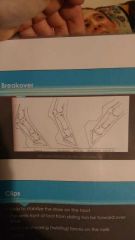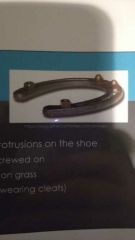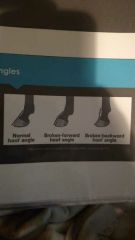![]()
![]()
![]()
Use LEFT and RIGHT arrow keys to navigate between flashcards;
Use UP and DOWN arrow keys to flip the card;
H to show hint;
A reads text to speech;
11 Cards in this Set
- Front
- Back
|
Materials |
Steel are most common, longer lasting, cheap
Aluminum are lighter, better shock absorber, less durable
Titanium- very rare
Synthetic- rubber or polyurethane, light, great shock absorber, can use w/ glue-ons - Police horses use these |
|
|
Sizes |
Range from Triple 0, double 0, 0, 1, 2, 3 and 4 Sized by dimensions of hoof length, width and circumference Companies vary size |
|
|
Shape |
Normal U shape Closed shoes- straight bar, egg bar, heart bar Bar shoes- provide support for heels, reduces stress on navicular region, DDFT, underrun heels, & sensitive feet |
|
|
Toe options and breakover |

Assist w/ break over Rolled toe- most common, rounded shape at front edge of hoof Rocker toe Squared toe Break over is how the foot rolls over the toe and lifts in each stride Break over point is the last point to leave the ground |
|
|
Clips |
- helps to stabilize shoe on hoof - prevents hoof from sliding too far forward - reduces shearing (twisting) forces on nails Types: - quarter clips - toe clips (usually only European thing) |
|
|
Creases and Nails |
Creases: - channels along ground surface of shoe that indents where nails go Nails: >100 styles usually steel - thinner nails used for thin/weak hooves - longer/heavier nails used for drafts - use fewest nails possible to preserve hoof wall |
|
|
Studs and Calks |

Aid in traction Round/rectangular protrusions on shoe - built in or "drill & tap" screw on - popular in showing on grass - like cleats for athletes |
|
|
Glue-on Shoes |
- no nails - glued on w/ epoxy - used on horses w/ poor hoof walls/soft feet - not good for long term use ELLIOT HAS THESE!!! |
|
|
Shoeing and Angles of Hoof |

Design shoe to match hooves Things to consider: - make sure hoof lands flat - even heels - good angles - breakover - fit & finish Angles: - angle of front of hoof wall: 52-55° - angle of hoof = angle of pastern |
|
|
Growth Rings |
Fine horizontal lines across hoof wall Hoof problems- deep/grooved ridges, can indicate prior health problems - Ex: fever, laminitis, nutritional change |
|
|
Corrective shoeing |
Club foot Unbalanced foot Contracted heels Navicular Ringbone Sidebone Laminitis Low heels Hoof cracks |

